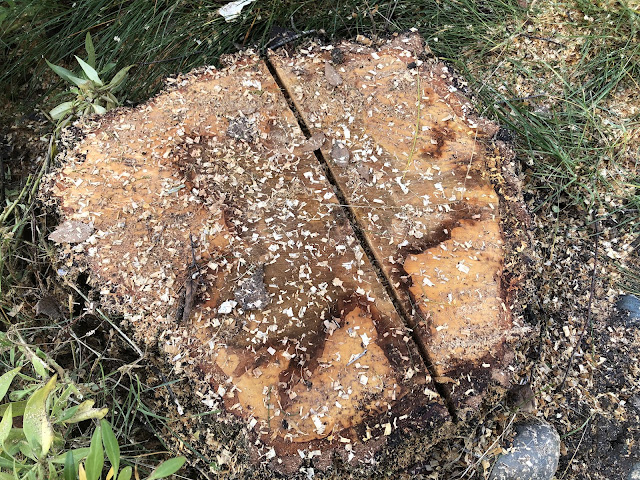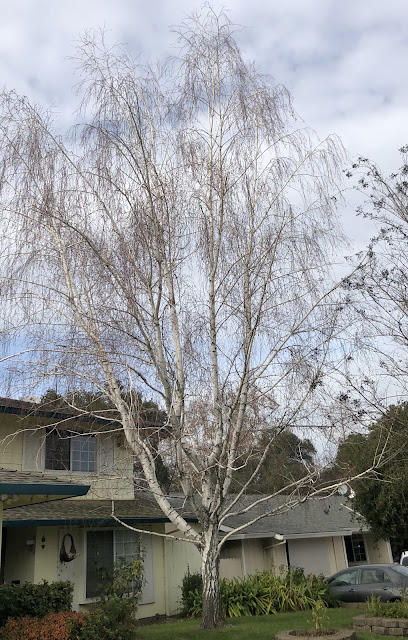
Birches aren't drought-tolerant and other things to know

|
|
This stump is all that's left of the fifth and last birch tree in my yard. (Photos:
Kathy Morrison)
|
The last of the five birch trees that were in our front yard bit the dust Wednesday. The tree crew took just 45 minutes to fell it, the branches hitting the muddy lawn with a loud "thud" as they were cut off.

|
|
Birches are prized for their white bark but
the branches can be brittle.
|
But the fifth tree was on the opposite side of the yard, the southern side, and it did a great job shielding some of the garden and house from the afternoon sun. (Of course it also dropped tons of small leaves in the fall.) The squirrels used it as part of their arborial highway, and the scrub jays often sat in the upper branches, keeping watch against predators while their nestlings slept in the nearby fern pine tree.
It takes a long time to kill a tree, so I think the big California drought of 2011-2017 spelled the eventual doom of this birch tree.

|
|
This birch tree in a Carmichael neighborhood looks healthier
than the one we had removed this week. |
My current neighborhood was built between 1962 and 1970, and some stands of birches remain, but they are looking their age. And people still plant them -- a house a block away has two relatively young trees growing right in the lawn.
Tree fans contend that there are no bad trees, only bad tree locations, and I'm inclined to agree.
Here's the truth of the matter: Birches are natives of very cold climates. They need moist soil, and their shallow, wide-spreading roots are vulnerable to heat and drought. That makes the white birch one of the worst trees you can plant in drought-prone California. The aphids, of course, are another issue.
This last birch put out roots under most of our front lawn, but the irrigation cutbacks were clearly hurting it. The leaves this past year were much sparser than in past seasons, and a few of the branches in the crown didn't have leaves at all. My neighbor was afraid it was going to fall on her house -- though it wasn't leaning -- so we had our favorite arborist come look at it.
He agreed that the tree was slowly failing and could lose the top in a heavy windstorm. Birches in our climate, he noted, have a life span of 15 to 20 years or so. And this tree was at least 25, probably more. He said we could have it topped or have it removed. I've seen a few pathetic topped birches in the neighborhood, and I didn't want that.
So down it had to go, and yesterday it did.
The yard seems more exposed, so I probably will plant some shrubby native perennials in that area, but not another tree. There are utility lines buried nearby and I don't want to chance disturbing them.
If you have a birch in your yard, keep a close eye on it. And while you're at it, get to know the other trees around you, to forestall future questions. A tree that doesn't match our climate can survive -- with extra care.
But natives and other low-water trees are better choices. The Sacramento Tree Foundation site is an excellent place to start learning about these, with loads of information on trees for local landscapes. It also has information on how to hire an arborist.
Comments
0 comments have been posted.Sacramento Digs Gardening to your inbox.
Sites We Like
Garden Checklist for week of May 12
Get your gardening chores and irrigation done early in the day before temperatures rise.
* Plant, plant, plant! It’s prime planting season in the Sacramento area. Time to set out those tomato transplants along with peppers and eggplants. Pinch off any flowers on new transplants to make them concentrate on establishing roots instead of setting premature fruit.
* Direct-seed melons, cucumbers, summer squash, corn, radishes, pumpkins and annual herbs such as basil.
* Harvest cabbage, lettuce, peas and green onions. This heat will cause leafy greens and onions to flower; pick them before they bolt.
* In the flower garden, direct-seed sunflowers, cosmos, salvia, zinnias, marigolds, celosia and asters.
* Plant dahlia tubers. Other perennials to set out include verbena, coreopsis, coneflower and astilbe.
* Transplant petunias, marigolds and perennial flowers such as astilbe, columbine, coneflowers, coreopsis, dahlias, rudbeckia and verbena.
* Keep an eye out for slugs, snails, earwigs and aphids that want to dine on tender new growth.
* Feed summer bloomers with a balanced fertilizer.
* For continued bloom, cut off spent flowers on roses as well as other flowering plants.
* Got fruit trees? If you haven't already done so, thin orchard fruit such as apples, peaches, pears, pluots and plums before they grow too heavy, breaking branches or even splitting the tree. Leave the largest fruit on the branch, culling the smaller ones, and allow for 5 to 6 inches (or a hand's worth) between each fruit.
* Thin grape bunches, again leaving about 6 inches between them. For the remaining bunches, prune off the "tail" end, about the bottom third of the bunch, so that the plant's energy is concentrated in the fruit closest to the branch.
* As spring-flowering shrubs finish blooming, give them a little pruning to shape them, removing old and dead wood. Lightly trim azaleas, fuchsias and marguerites for bushier plants.
* Add mulch to the garden to help keep that precious water from evaporating. Mulch also cuts down on weeds. But don’t let it mound around the stems or trunks of trees or shrubs. Leave about a 6-inch to 1-foot circle to avoid crown rot or other problems.